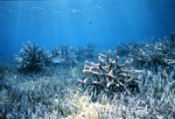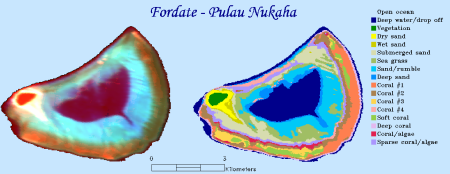Bottom-type classification - What's on the sea floor?

Scientists doing research on coral reefs need to know where coral reefs can be found and where other kinds of bottom-types (algae, coral, seagrass, sand…) are located.
Therefore, a map of the coastal area needs to be constructed, where the location of all classes of bottom-types are visualized.
How to determine bottom-types
Most coral-reef bottom types have typical spectral signatures with pronounced differences between one another.
This spectral signature permits the researcher to recognize the different bottom-types. In the case of seagrasses, spectral reflectance values may even be used to discriminate different species.
Bottom-type classification and resolution
Compare the classification derived from an image acquired by the sensor CHRIS onboard satellite Proba (resolution 18 m) with the classification derived from hyperspectral data (CASI airborne sensor, resolution 2,5 m).


Can you find a noticeable difference between both classifications?
But it isn't always that simple…
The spectral signature of some bottom-types doesn't differ much from others. For example, seagrass beds and coral-dominated parts of a reef have very similar reflectances. In that case, it is necessary to appeal to other sources of information to make the distinction:
- Spatial organization
Unlike their similar reflectances, they differ significantly in their spatial organization: while coral-dominated bottom types are typically very heterogeneous, seagrass beds are relatively homogeneous. - Location on the reef
Seagrass generally occurs in sheltered environments like lagoons. Pixels which have been classified as seagrass and occur on a part of the reef that is highly exposed to wave energy are therefore very likely misclassifications. These zones in contrast are favorable to coral growth. In thise case, these dubious pixels are assumed to represent a coral-dominated bottom-type in reality.
Have a look at a case study of a bottom-type classification near Jebel Ali in the southern Arabian Gulf.
